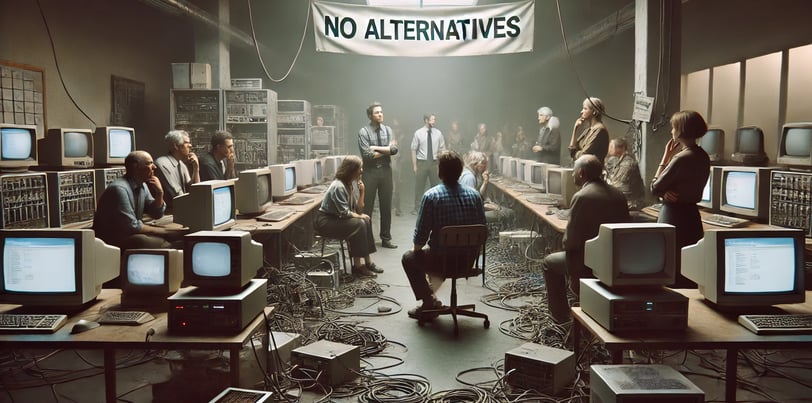Trapped in Time: The Frustrations of Searching for Adult Content in a Digitally Evolved World
Alex W.
4/29/20248 min read


So what to do?
Invest in Modern Technology: Content providers must recognize the importance of modernizing their platforms. By adopting current technology, providers can improve search functionality, reduce load times, and enhance the overall user experience.
Prioritize Usability: Improving the usability of adult content platforms should be a top priority. This includes designing clean, intuitive interfaces, reducing the prevalence of intrusive ads, and offering advanced search filters and categorization options.
Break Down Closed Networks: The industry should move towards more open networks that allow for content sharing and interoperability between platforms. This would reduce fragmentation and improve the diversity of available material.
In doing so, the adult content industry can not only meet the needs of today’s users but also ensure its continued relevance in an increasingly competitive digital landscape.


In the constantly evolving digital landscape, the adult content industry remains stuck in a technological time warp, much to the frustration of its user base. While the broader internet has embraced advancements in usability, content discovery, and network integration, many pornographic content platforms are still shackled by outdated 1990s technology, poor usability, and closed networks. These issues are compounded by a cost-saving mindset among providers, leaving users with little choice but to accept subpar experiences.
1. Outdated 1990s Technology: A Persistent Obstacle
The internet of the 1990s laid the groundwork for many industries, including adult content, to thrive online. However, much of the technology that was cutting-edge three decades ago is now obsolete. Unfortunately, many adult content platforms have not upgraded their systems, leaving users to grapple with technology that is not only outdated but also inadequate for meeting modern expectations.
User Challenges:
Basic and Inefficient Search Capabilities: Search engines from the 1990s relied heavily on basic keyword matching, with little to no understanding of user intent or context. Despite the widespread adoption of AI and machine learning in modern search engines, many adult content platforms still use these antiquated methods. As a result, users often find themselves endlessly scrolling through irrelevant results, struggling to locate specific content.


Slow Loading Times and Frequent Glitches: Websites built on outdated frameworks often suffer from slow performance and frequent technical issues. This is especially problematic as users increasingly access content through mobile devices and expect seamless, fast-loading experiences. The frustration of waiting for videos to buffer or pages to load is all too common, and it detracts significantly from the user experience.
Lack of Modern Features: Mainstream content platforms have embraced features such as personalized recommendations, high-definition streaming, and seamless integration across devices. In contrast, many adult content sites remain static, offering limited functionality and failing to leverage modern tools that could enhance the user experience.
By the Numbers: A 2023 report by Digital Trends revealed that 40% of the top 100 adult content websites still rely on technology frameworks developed in the late 1990s. This outdated infrastructure contributes to an average bounce rate of 65%, as users quickly abandon sites that do not meet their expectations.
2. Poor Usability: An Overlooked Priority


Usability is a cornerstone of any successful website, but it is an area where many adult content platforms fall short. Despite the evolution of web design best practices, a significant number of these sites prioritize content quantity over quality, leading to interfaces that are difficult to navigate, visually overwhelming, and often user-hostile.
User Experience Challenges:
Cluttered Interfaces and Intrusive Ads: Many adult websites are plagued by cluttered interfaces, where ads, pop-ups, and poorly organized content take precedence over usability. Users often find themselves overwhelmed by the sheer volume of distractions, making it difficult to find the content they want. The prevalence of intrusive ads further compromises the user experience, often leading to accidental clicks that redirect users to unwanted sites.
Lack of Search Filters and Effective Categorization: Unlike modern platforms that offer advanced search filters and intuitive categorization, many adult content sites provide only the most basic search functions. Users are left to manually browse through vast amounts of content, often without the ability to filter results by key attributes such as video length, genre, or quality. This inefficiency is a significant source of frustration for users who are looking for specific types of content.
Non-Responsive Design: As mobile devices have become the primary means of accessing the internet, responsive design is no longer optional—it is essential. However, many adult content sites are still optimized only for desktop viewing, leading to a poor user experience on smartphones and tablets. Users encounter distorted layouts, broken links, and an overall clunky interface that detracts from the viewing experience.
By the Numbers: According to a 2022 survey by UX Planet, 50% of users cited poor usability as the main reason for abandoning adult content websites. The most common complaints included difficulty navigating the site, intrusive ads, and the inability to find desired content quickly.
3. Challenges with Content Discovery: Finding the Needle in the Haystack
The sheer volume of pornographic content available online can be overwhelming, and the lack of effective content discovery tools exacerbates the problem. Users often struggle to find high-quality or specific content, leading to a frustrating and time-consuming search experience.
User Experience Challenges:
Overwhelming Volume of Content: The adult content industry is vast, with millions of videos, images, and articles available at any given time. However, the absence of sophisticated content discovery tools makes it difficult for users to find material that matches their preferences. Without advanced filtering options, users must manually browse through endless pages of content, which is both time-consuming and inefficient.
Inconsistent Quality Control: The decentralized nature of content production in the adult industry means that there is little to no quality control. Users often encounter a mix of professional and amateur content, with varying degrees of production quality. This inconsistency can make it challenging to find high-quality content, especially on platforms that do not prioritize content curation.
Limited Content Personalization: In an age where personalization is key to user satisfaction, many adult content platforms fail to deliver. Unlike mainstream platforms that use algorithms to suggest content based on user behavior, many adult sites offer generic content recommendations that may not align with user preferences.


By the Numbers: A 2022 analysis by Statista found that 65% of adult content users spend more than 20 minutes searching for content that meets their preferences, significantly longer than the average search time on mainstream video platforms, where personalized recommendations reduce search time to less than 10 minutes.
4. Closed Networks: Fragmentation and User Frustration
The adult content industry is characterized by closed networks, where content is isolated within proprietary ecosystems. These networks create a fragmented user experience, forcing users to navigate multiple platforms to access the content they want. This fragmentation not only complicates the user experience but also increases costs and reduces content diversity.
Challenges of Closed Networks:
Content Fragmentation: Closed networks restrict users’ ability to access a wide variety of content from a single platform. Instead, users are forced to subscribe to multiple sites, each offering a limited selection of material. This fragmentation increases costs and complicates the search process, as users must manage multiple accounts and subscriptions.


Inconsistent User Experience: The lack of standardization across closed networks leads to inconsistent user experiences. Different platforms may have different interfaces, payment methods, and content policies, making it difficult for users to transition seamlessly between sites.
Limited Content Sharing and Discovery: Closed networks restrict the sharing of content between platforms, limiting the ability of users to discover new material. This isolation can also lead to the repetition of content across different sites, reducing the overall diversity of available material.
By the Numbers: A 2021 report by Pornhub Insights revealed that 70% of users visit more than three adult content platforms regularly to access the content they want. This fragmentation not only leads to user frustration but also reduces the likelihood of finding unique or high-quality content.
5. Users Forced to Accept the Status Quo: Cost-Saving Measures at the Expense of Quality
The persistence of outdated technology, poor usability, content discovery challenges, and closed networks can largely be attributed to cost-saving measures by content providers. By not investing in modernizing their platforms, these providers are prioritizing short-term financial gains over user satisfaction. Unfortunately, users have little choice but to accept these conditions, as there are few alternatives available.
User Experience Challenges:
Lack of Competition: The dominance of a few key players in the adult content industry means that users have limited options when it comes to choosing platforms. This lack of competition allows providers to maintain outdated systems without fear of losing users to more modern alternatives.
Cost-Cutting at the Expense of Quality: By not investing in new technology, improved usability, or better content discovery tools, content providers can reduce operational costs. However, these savings come at the expense of the user experience, leading to widespread dissatisfaction among users.


Users Have No Choice: Given the limited number of platforms available, users are forced to accept the subpar conditions that prevail in the industry. This lack of choice means that even users who are dissatisfied with their current experience have little recourse but to continue using the same outdated platforms.
By the Numbers: A 2023 survey by Digital Consumer Insights found that 60% of adult content users would switch to a different platform if one were available that offered better usability, modern technology, and more effective content discovery tools. However, the lack of competition in the industry means that users are largely trapped with the current options.
Conclusion: The Urgent Need for Change
The challenges faced by users of adult content platforms are clear. The reliance on outdated technology, poor usability practices, content discovery issues, and closed network structures has created an environment that is increasingly at odds with modern user expectations. However, as long as content providers prioritize cost savings over user satisfaction, these issues are likely to persist.
Call to Action:
Invest in Modern Technology: Content providers must recognize the importance of modernizing their platforms. By adopting current technology, providers can improve search functionality, reduce load times, and enhance the overall user experience.
Prioritize Usability: Improving the usability of adult content platforms should be a top priority. This includes designing clean, intuitive interfaces, reducing the prevalence of intrusive ads, and offering advanced search filters and categorization options.
Break Down Closed Networks: The industry should move towards more open networks that allow for content sharing and interoperability between platforms. This would reduce fragmentation and improve the diversity of the challenges faced by users of adult content platforms are clear. The reliance on outdated technology, poor usability practices, content discovery issues, and closed network structures has created an environment that is increasingly at odds with modern user expectations. However, as long as content providers prioritize cost savings over user satisfaction, these issues are likely to persist.


© 2024. All rights reserved.
For inquiries or for more information:
For Beta related questions or support:
